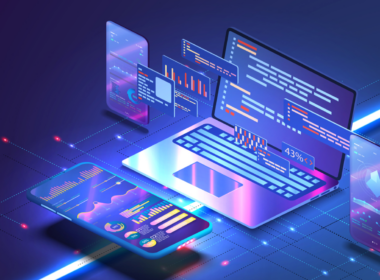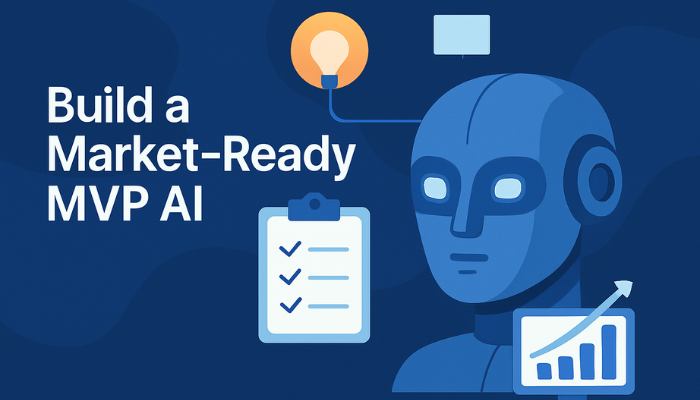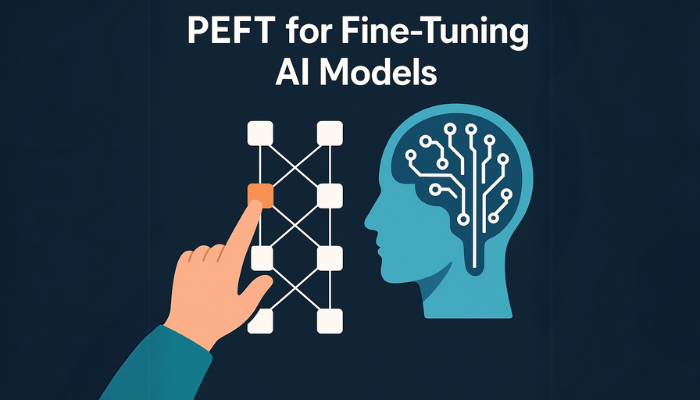In business today, staying competitive means finding smarter ways to operate. AI is the tool that’s already helping companies make faster, more informed decisions while cutting costs and boosting growth. For decision-makers like you, the question isn’t about “if” AI should be adopted, it’s about “how” quickly you can implement it to stay ahead.
Whether it’s optimizing operations, automating routine tasks, or unlocking insights from big data, AI is delivering measurable results that matter to your bottom line. It’s not a future possibility, it’s happening right now, and businesses that aren’t integrating it risk being left behind.
Let’s check out the facts and figures that show how AI is already helping industries and why it should be a priority in your strategy.
AI Market Growth and Impact
Check out these key insights on AI’s rapid growth and its increasing role in shaping business strategies across industries.
- The global AI market is currently valued at over $600 billion.
- Over the next five years, the AI industry is expected to increase in value by more than five times.
- By 2026, the U.S. AI market is projected to reach approximately $299.64 billion.
- The AI market is growing at a compound annual growth rate (CAGR) of 37.3% from 2022 through 2030.
- 83% of businesses identify AI as a key priority in their strategic plans.
- Netflix generates around $1 billion each year through automated personalized recommendations.
- Nearly half (48%) of businesses use AI to harness and analyze big data efficiently.
- 38% of healthcare providers are using AI-driven systems for diagnostic assistance.
The numbers speak for themselves. Let’s break down some of the most eye-opening facts that show exactly how transformative AI is.
Must-Know AI Facts and Figures Shaping the Future of Business
Artificial Intelligence (AI) allows businesses to analyze large data sets, spot trends, and make quick decisions. It enhances operational efficiency, drives innovation, and helps businesses stay competitive. For decision-makers, AI is a powerful tool to improve productivity, predict market shifts, and optimize customer experiences, ultimately impacting the bottom line.
Here’s a look at some surprising stats that show just how deeply AI has woven itself into the fabric of everyday life.
1. Sophia: The First Robot Citizen
Sophia made history in 2017 by becoming the first robot to receive legal personhood in Saudi Arabia. Created by Hanson Robotics, this humanoid AI can interact with people and express human like emotions. Sophia is part of a growing family of humanoid robots, showcasing the potential of AI in human-robot interaction.
For business leaders in customer service, Sophia and similar robots can be used to enhance customer interactions, automate routine tasks, and reduce staffing costs. This could be particularly valuable for industries like hospitality and retail, where customer engagement is crucial.
2. AI’s Expanding Capabilities
AI has evolved from simply generating text to mastering multimodal tasks, including analyzing and generating audio and visual data. This innovation enhances AI’s ability to identify faces and voices accurately, even with different angles and background noise, revolutionizing fields like security and customer service.
AI’s ability to analyze audio and visual data can significantly improve security systems, marketing analytics, and customer support. For decision-makers, it provides an opportunity to enhance customer experiences through personalized services, especially in sectors like banking, security, and retail.
3. AI Pets: Replacing Traditional Companions?
AI-powered pets are emerging as a replacement for traditional dogs and cats. For instance, Go1, an intelligent quadruped robot developed by China’s Unitree Robotics, mimics a dog’s movements but requires no care or vet bills. These AI companions might change how we think about pets in the future.
Businesses in the pet care and healthcare sectors can benefit from AI companions by reducing costs related to traditional pet care and improving services for elderly or disabled customers who need robotic companions for support.
4. AI Has Been Around Longer Than You Think
Though AI seems like a modern phenomenon, it has roots dating back to the early 1900s. While major breakthroughs came in the 1950s, the foundation for today’s AI was laid much earlier by pioneering researchers who set the stage for this transformative technology.
Understanding AI’s history and its evolution allows business leaders to better integrate existing AI technologies into their strategies. Whether in manufacturing, healthcare, or financial services, businesses can leverage AI for process automation and data-driven decision-making.
5. Predicting Death with AI
In an unsettling but groundbreaking development, an AI model trained by Stanford researchers can predict death with up to 90% accuracy. This could change the way healthcare providers approach end-of-life care, giving patients and families a clear timeline to prepare for the inevitable.
For healthcare providers, this predictive capability could enhance the quality of patient care, help with resource management, and even reduce healthcare costs by optimizing the allocation of staff and facilities.
6. The Gender Bias of AI Voices
Many AI systems, from Siri to Alexa, use female voices due to research suggesting that people perceive female voices as more trustworthy and helpful. While some AI models feature male voices, the choice often depends on the brand’s target audience.
Companies in the tech industry need to be aware of these biases when designing their AI systems. By customizing AI voices to match customer preferences and expectations, brands can improve user satisfaction and create more engaging, inclusive experiences.
7. Robot Journalism: The Future of Reporting
AI is making its mark in journalism, with robots now capable of reporting news. For example, the Los Angeles Times used an AI system to report on earthquakes in California. This form of “robot journalism” is becoming more common in the media industry.
For media companies, AI-driven journalism can improve efficiency and reduce operational costs. By automating routine news reports, businesses can focus on higher-level reporting while improving content output and speed.
8. AI Shoppers: Your Personal Assistant
Ever noticed how online stores suggest products you might be interested in? That’s AI at work, tracking your browsing and purchase history to predict your future buying habits. These personalized recommendations are becoming an essential part of the online shopping experience.
For e-commerce businesses, AI-driven recommendations boost sales by personalizing the shopping experience. Business leaders can use AI to predict consumer behavior, increasing conversion rates and customer satisfaction.
9. AI in Business: A Market Explosion
AI in business is expected to grow quickly, with its value rising from $1.62 billion in 2018 to $31.2 billion by 2025. This shows how businesses are using AI to stay competitive and innovate.
For business leaders, this growth offers a chance to use AI tools that can make operations more efficient, like automating logistics, improving financial planning, and strengthening customer relationships.
10. AI and Emotional Intelligence
AI is increasingly able to assess human emotions by analyzing facial expressions, voice tones, and even text. While it’s still imperfect, especially when it comes to sarcasm and complex emotions, AI’s ability to understand and react to human feelings is improving, with applications in customer service and healthcare.
Companies in customer service, marketing, and healthcare can benefit from AI’s emotional intelligence to better connect with their customers, deliver more personalized experiences, and improve customer retention.
11. AI Creates Thought-Provoking Art
AI has also ventured into the art world, with programs like AARON generating original artwork. One AI-created painting sold for $432,500 in 2018, proving that artificial intelligence can push the boundaries of creativity.
In creative industries, businesses can use AI to generate unique designs at a fraction of the cost of human artists. This could lead to new revenue streams in art, advertising, and branding, while also enabling quicker production cycles.
12. More AI Assistants Than Humans
By 2025, AI-powered assistants are predicted to outnumber humans, with an estimated 8.4 billion AI assistants in use. This shift indicates a future where AI is deeply embedded in everyday life, impacting everything from personal devices to workspaces.
For business leaders, AI assistants can automate customer interactions, simplify internal processes, and improve efficiency. This provides a significant return on investment, especially in industries like retail, finance, and telecommunications.
Want to build your own AI assistant? Codewave’s got you covered—let’s create something amazing for your business!
13. AI in the Automotive Industry
AI is transforming the automotive industry, with self-driving cars set to bring significant savings in the coming years. In the near future, most new vehicles are expected to include some form of AI, leading the way for smarter, potentially driverless cars.
For car manufacturers, AI improves vehicle performance, enhances safety features, and refines design. These innovations open new markets, reduce production costs, and help companies stay competitive as the electric and autonomous vehicle sectors continue to evolve.
14. AI Can Predict Earthquakes
AI is also being used to predict natural disasters, such as earthquakes. By analyzing vast amounts of data from past events, AI can identify patterns and potentially predict when and where disasters might strike, providing a crucial early warning system.
For businesses in construction, infrastructure, and insurance, AI’s predictive capabilities can help mitigate disaster risks, improve safety protocols, and optimize emergency response strategies, potentially saving millions in damage costs.
15. The Black-Box Problem in AI
One of AI’s biggest challenges is the “black-box” problem, where the decision-making process of AI models is not transparent. This lack of clarity raises concerns, particularly in critical areas like healthcare, where understanding AI’s reasoning is essential.
Businesses in sectors like healthcare, finance, and law need to address this issue to ensure AI decisions are explainable, fair, and trustworthy. Solving the black-box problem will build confidence in AI’s applications and ensure compliance with regulations, especially in highly regulated industries.
16. The First AI Chatbot: Eliza
Eliza, created in 1966, was the first AI chatbot and a precursor to today’s sophisticated virtual assistants. Although primitive by today’s standards, Eliza paved the way for the conversational AI we rely on today.
For business leaders in retail, banking, and healthcare, implementing AI chatbots can significantly reduce service costs, improve response times, and enhance customer satisfaction through 24/7 availability.
Missing a personal touch on your website? Codewave’s video chatbots can help!
17. AI Software Market: On Track for $100 Billion by 2025
The AI software market is set to explode, with estimates suggesting it could hit $100 billion by 2025. This growth is driven by increasing demand for AI and machine learning development across various sectors.
18. AI in Surgery: A New Era in Healthcare
AI is also making its way into the operating room, assisting with surgeries and helping surgeons make real-time decisions. This application of AI is enhancing the precision and outcomes of surgeries, making it a game-changer for the medical field.
Healthcare providers and medical equipment manufacturers can leverage AI to improve surgical precision, reduce recovery times, and minimize human error, leading to better patient outcomes and higher operational efficiency in hospitals and clinics.
19. AI: More Transformative Than Electricity and Fire
Google CEO Sundar Pichai has stated that artificial intelligence will surpass even electricity and fire in its transformative potential for humanity. He believes AI will revolutionize every aspect of life, from personal experiences to global industries, fundamentally altering the course of human progress.
AI is fundamentally altering how businesses operate and make decisions. For business leaders, AI offers the potential for groundbreaking innovations in every industry, from automating manufacturing to revolutionizing customer service and predictive analytics.
20. AI Spending to Surpass $50 Billion by 2025
According to the International Data Corporation (IDC), AI spending in Europe was projected to reach $22 billion in 2022. This figure is expected to more than double, surpassing $50 billion by 2025. The rapid increase highlights the growing demand for AI-driven solutions across various sectors.
21. Surge in AI Startups
The number of AI startups has increased 14 times since 2000. This surge highlights the rapid expansion of AI technologies and the increasing demand for innovative solutions across industries. Entrepreneurs and businesses are adopting AI and tapping into its transformative potential.
For entrepreneurs and business leaders looking to innovate, this surge in AI startups signals a wealth of new solutions and partnerships. Businesses can tap into the growing startup ecosystem to incorporate cutting-edge AI technologies into their operations, offering a competitive edge in their respective industries.
22. Global AI Market to Reach $190.61 Billion by 2025
The global AI market is experiencing rapid growth, with projections showing it will reach $190.61 billion by 2025. This growth is driven by a compound annual growth rate (CAGR) of 36.62%. As industries continue to adopt AI technologies, its economic impact will only intensify, with businesses and governments investing heavily in AI-driven innovations across various sectors.
23. AI Set to Add $15.7 Trillion to Global GDP by 2030
By 2030, artificial intelligence is expected to contribute an astonishing $15.7 trillion to the world’s GDP, representing a 14% boost. This economic surge will come from AI’s ability to streamline processes, enhance productivity, and create new industries. As AI continues to evolve, its role in driving global economic growth will become even more pivotal.
24. Most Consumers Believe AI Will Improve Their Lives
A survey by Strategy Analytics found that 41% of consumers across India, China, Western Europe, and the United States believe emerging AI technologies will enhance their quality of life. People are optimistic about AI’s ability to improve everything from convenience to personal well-being, suggesting a growing trust in AI’s potential to reshape society for the better.
Businesses can capitalize on this consumer trust by adopting AI to enhance customer experiences, streamline operations, and provide innovative products/services that meet rising consumer expectations.
25. Many People Don’t Realize They’re Using AI
Surprisingly, only 34% of consumers are aware that they are directly interacting with AI, according to a study by Pegasystems Inc. Despite this, 84% of respondents use AI-powered devices or services daily, such as virtual assistants, recommendation systems, or smart home devices.
26. 34 Million AI-Generated Images Created Daily
Using one of over 2,000 AI image generation tools available online, 34 million AI-generated images are created every day. This marks a major shift in visual content creation, as businesses and individuals increasingly turn to AI for everything from marketing materials to conceptual designs without the traditional constraints or costs.
For marketing teams, this represents an opportunity to produce high-quality visual content quickly and at scale. AI-generated visuals can be used in advertising, social media campaigns, and product design, saving time and reducing costs for businesses.
27. 71% of Social Media Images Now AI-Generated
AI-generated imagery has taken over social media, with 71% of images now created using AI. This growing trend lowers the barriers to visual content creation for brands and influencers, but it also raises important questions about authenticity in the digital space.
For brands and influencers, AI provides the ability to create visually appealing content without the costs and time constraints of traditional photography or design work, allows businesses to scale their social media efforts efficiently.
28. Deepfake Fraud Attempts Surge to 6.5% Worldwide
Deepfake fraud attempts have skyrocketed, increasing from 0.01% in 2022 to 6.5% globally. This alarming rise highlights one of the darker sides of AI technology, pushing organizations to invest heavily in detection and authentication methods to protect both consumers and systems.
For businesses in cybersecurity, banking, and law enforcement, the rise in deepfake fraud presents the need for advanced AI-driven detection systems. Businesses can invest in AI tools to protect their brand and customers from fraud while maintaining trust.
29. Tech Giants Investing $320 Billion in AI Development by 2025
Tech giants are pouring massive investments into AI, with a projected $320 billion in funding by 2025. This significant investment will drive even more innovation and advancements in AI technologies across industries.
30. 25% of Enterprises Will Deploy AI Agents This Year
AI is becoming more integrated into business operations, with 25% of enterprises planning to deploy AI agents in 2025. This adoption is expected to improve efficiency, automate processes, and create new opportunities for growth in various sectors.
Also Read: Top AI Agents Transforming Business Productivity in 2025
Your Next Step with CodeWave
Let Codewave help you integrate AI seamlessly into your operations!
As AI continues to grow, it’s not just changing industries, it’s changing the way we work. While some jobs are being automated, AI is also opening up new roles and opportunities. So, how does this impact you and your career?
Let’s dig into what AI means for employment, both now and in the future.
Current and Future Employment with AI
Artificial Intelligence is transforming the workforce, creating new job opportunities while also reshaping existing roles. By 2025, up to 97 million people are projected to work in the AI sector. Additionally, 83% of companies report that AI is a top priority in their business strategies.
Also Read: Exploring Real World Uses of AI in Automation
How AI is Opening New Doors
Gen AI has the potential to democratize access to jobs, making it easier for individuals to acquire the technical skills that were once out of reach for many qualified workers.
Instead of eliminating entry-level roles, AI could be used to train and develop the next generation of senior professionals. This shift could redefine traditional career paths, with more emphasis on apprenticeships and hands-on training, and industries like law moving away from billable hours.
As AI continues to embed itself in the workplace, companies will need to invest in upskilling their employees to prepare for the AI-driven economy, ensuring a workforce ready to thrive in the future.
Also Read: Key AI Trends to Watch in 2025
Conclusion
Woah, you think AI has already made its mark? Well, think again, this is just the beginning! While we’ve seen how AI is closing some doors in the workforce, it’s also opening up new, exciting opportunities for those who are ready to adapt. It’s not about the jobs AI takes, but the new kinds of roles it creates that will shape the future.
AI is here, and it’s making waves in ways we never thought possible. If businesses want to stay ahead of the game, they’ve got to embrace this change, move fast, and start thinking smarter. That’s where having the right AI partner comes in.
And that’s where Codewave comes in.
Why Codewave is the AI Partner You Need:
- AI Software Development: We build custom AI solutions customized to your business. We use technologies like TensorFlow, PyTorch, and Scikit-learn to build AI applications. Whether it’s developing machine learning models or integrating NLP for customer insights, our AI systems solve real-world business problems.
- AI-Powered Applications: We develop intelligent mobile and web apps using React, Angular, and Vue.js for front-end, and Python or Node.js for back-end, incorporating AI features like chatbots, recommendation systems, and predictive analytics to boost user engagement and efficiency.
- Cloud-Based AI Integration: With AWS, Google Cloud, and Azure, we deploy scalable AI solutions for your business, from cloud-native applications to real-time data processing and AI-powered automation. We ensure your AI infrastructure is secure, scalable, and ready to grow with your business.
Let’s not wait for the future, let’s create it! Get in touch with Codewave today and see just how AI can work wonders for your business.
Up Next: Exploring Top AI Development Companies
Codewave is a UX first design thinking & digital transformation services company, designing & engineering innovative mobile apps, cloud, & edge solutions.







